Last Updated on June 27, 2025


Yogyakarata or as locals call it “Jogja” is a bustling city in Java. It is rich in history with its impressive temples. The most famous temples are Prambanan and Borubudor. Prambanan is located about 12 kilometers east of the city center while Borubudor is located northwest about 40 kilometers away.
We visited both temples in early July 2023. We stayed in Yogyakarta for four nights so we could have an off day between visiting the two temples. We are glad for this experience and to share it with you.
Getting to Yogyakarta City Center


We flew into Yogyakarta’s new international airport (YIA) about 42 kilometers southwest of the city. There are three ways to get from the airport to the city center. These are by train, bus and ride share.
Train is by far the cheapest and probably the fastest. The person we asked at the airport said that buses take too long because it has many stops to pick up and drop off passengers. It is more expensive than the train too according to an airport employee. The rideshares available in Indonesia are Grab and Gojek. Those would also be far more expensive than the train and not any faster.
KAI Train
The airport to city center train is operated by KAI. It’s not a modern train compared to those in Europe but its clean and roomy. The seats are arranged 2 x 2 with generous legroom. We actually could put our carry-on luggage in front of us and did not feel cramped at all.
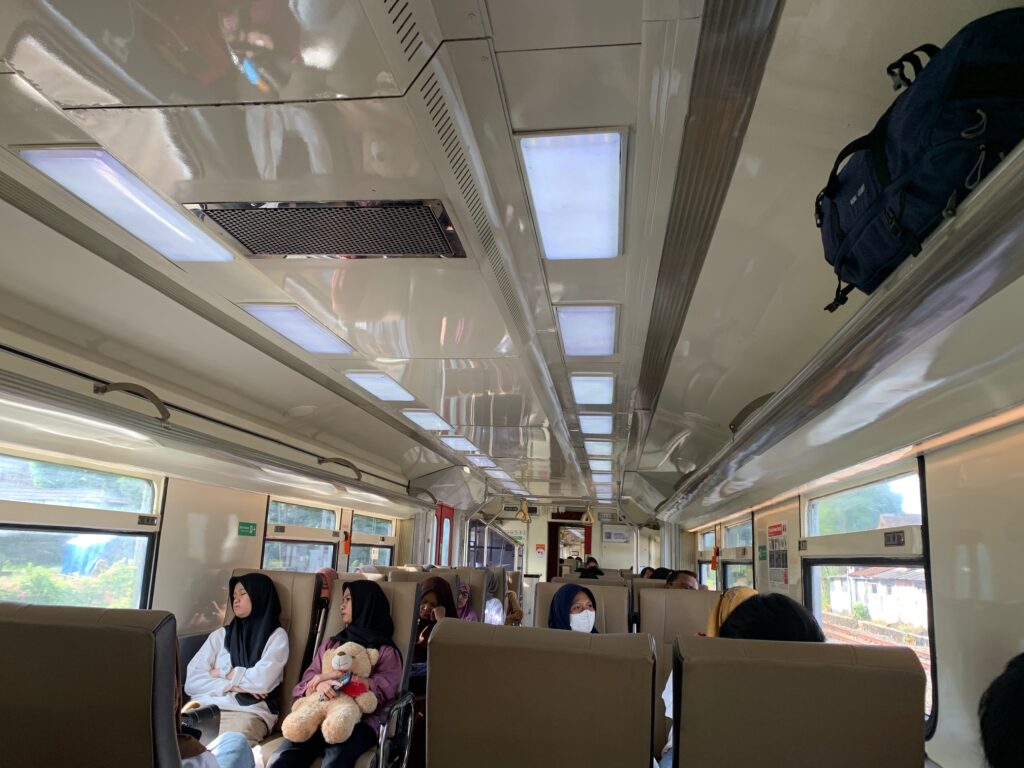

There is an express train and a non-express train. The express train has no intermediate stop between the airport and the city center. The non express train stops at Wates which is between the airport and city center. We took the non express train and it cost 20K IDR per person. The stop at Wates was only about 10 minutes.
At the city center train station, we just hired a Grab rideshare to get to our accommodation. We arrived around 5 PM so traffic was heavy. It took us about 40 minutes to travel just over 4 kilometers. But the cost of the rideshare was only 35,000 IDR ($2.33).
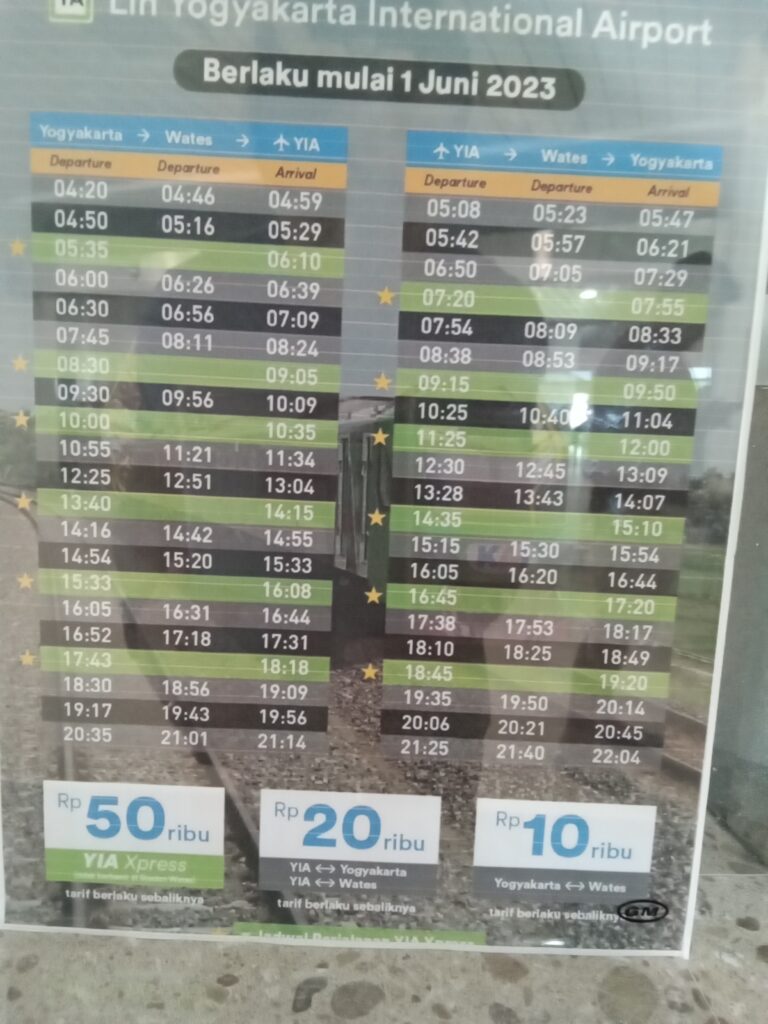

Tip: The trains have limited schedules. Get your train ticket as soon as you arrive. We showed up at the train station’s ticket counter 30 minutes before our desired departure and it was full, as well as the next scheduled train. We ended up getting on the train that ran about 2 hours later than the one we wanted to take.
Visiting Prambanan Temple Complex
It is another 12 kilometers from our accommodation to the Prambanan Temple Complex. We hired a Gojek using the app and we were at the temple’s parking lot gates 30 minutes later. Our driver dropped us off before the parking lot gate. We paid our driver in cash as we had not uploaded our credit card yet when we hailed our ride.
We walked past the parking lot gate pay station and towards the park’s main entrance. There is a big sign for foreigners to enter the single story building to the left. There is a long counter inside the building and behind it is a TV screen showing the different admission prices.
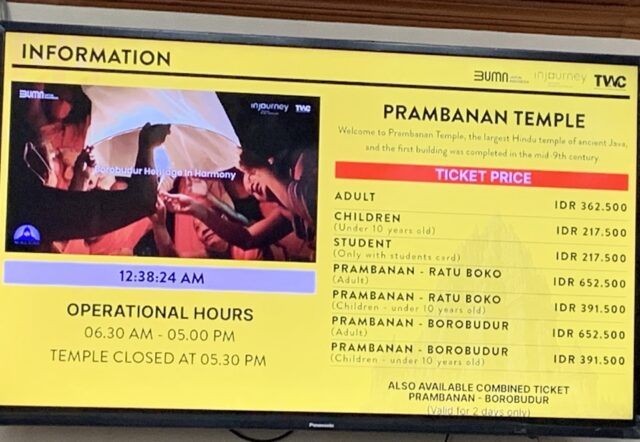

The Prambanan Temple Complex has four temple ruins which are Prambanan, Lumbung, Bubrah and Sewu. The closest to the main admission gate is Prambanan with its towering spires that are visible from the main road. Sewu is the next largest temple and Lumbang and Bubrah are smaller temples.
South of the Prambanan Temple Complex is the Ratu Boko ruins. We opted for the combo ticket of Prambanan and Ratu Boko. The deal with the combo ticket is that Ratu Boko needs to be visited first. Included in the combo ticket is the shuttle van that takes people to Ratu Boko from Prambanan and back. We were given a ticket with a number at the shuttle waiting area. The tickets serve as our queue to get on the shuttle van. There is also a park personnel in charge to make sure that nobody cuts in line by collecting the shuttle ticket before allowing anybody to board.
The temple complex accepts credit cards for payment.
Ratu Boko Ruins
The Ratu Boko ruins is up on a hill about five kilometers south of the Prambanan Complex as the crow flies. However, the ride there is through narrow busy streets that it took us about 20 minutes to get to the main entrance. We scanned our tickets through the entry gate and walked up some stairs to reach the ruins.
The main draw of the Ratu Boko Ruins are the two stone entry gates. It reminded us of the Machu Picchu ruins in Peru because of how stones are neatly stacked on top of each other without any visible gaps. There is really not much beyond the two gates except for Public Hall and Bathing Place which is located at the far end of the complex. We were not able to visit the Public Hall and Bathing Place because we did not know it was there as there were no people walking in its direction.
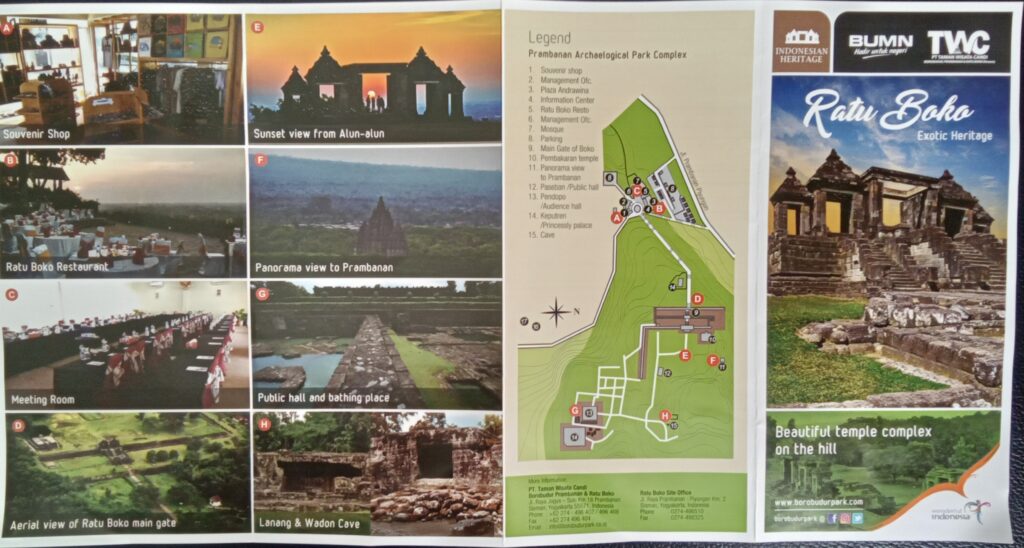

Tip: Ask for a map of the Roto Boko Ruins at the restaurant which is where you will be dropped off. This way you can plan where you want to go and not miss anything.
Prambanan
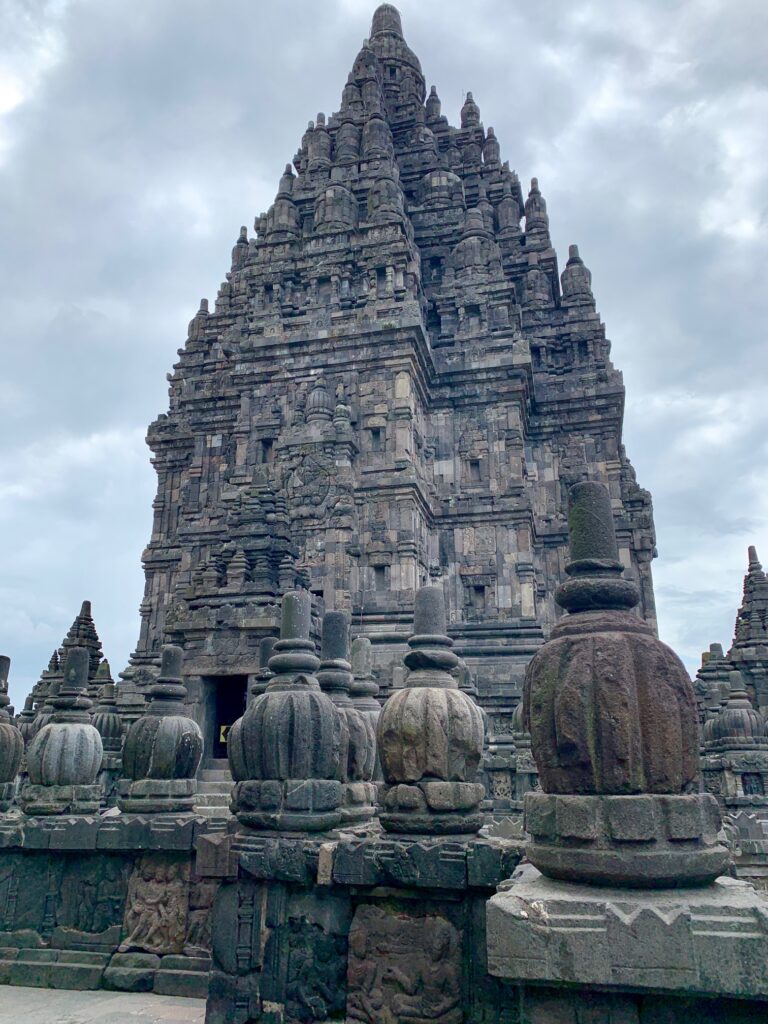

Prambanan is a collection of three Hindu temples which are named Brahma, Shiva and Vishnu. Shiva temple is the largest and tallest and flanked by Brahma to the South and Vishnu to the north. There are smaller temples in front of the big temples as well as to the side.
When we were there, we estimated that more than 99 percent of the visitors just visit the Prambanan temples. So it is very busy. Taking a picture without being photobombed is next to impossible.


People are allowed to go inside the temples. There is a sign at each temple that indicates the number of people allowed to be inside the temple. The temples do provide Instagram worthy photos especially on a clear day with blue skies.
Lumbung Ruins
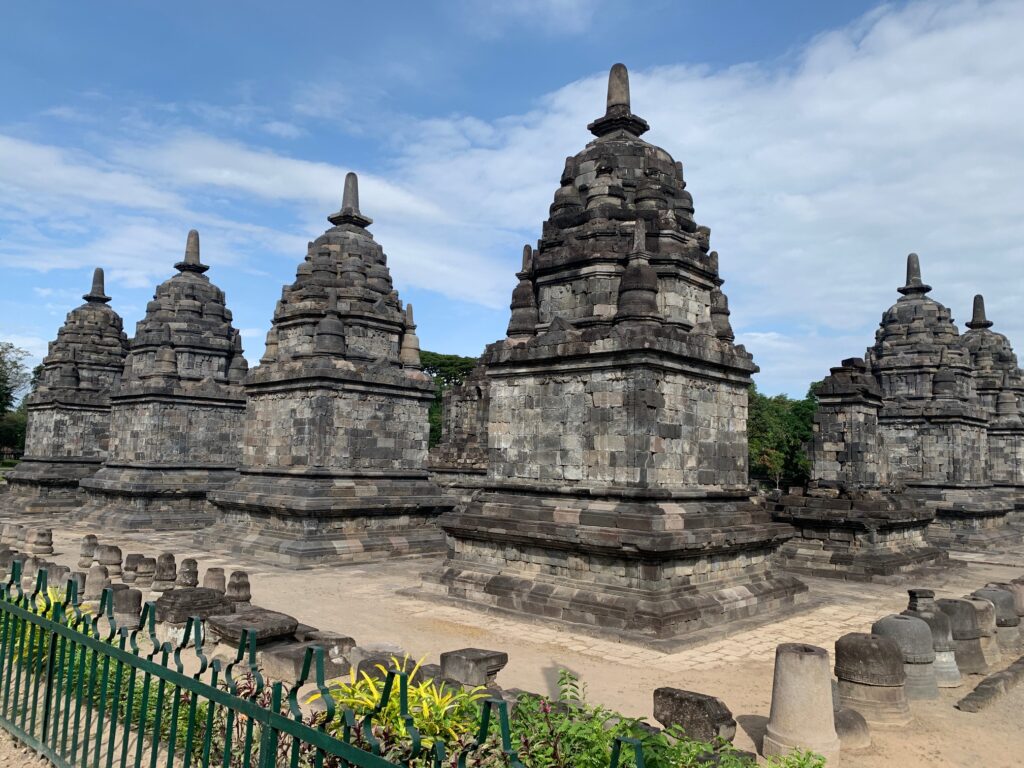

The next ruin we walked to was Lumbung. It is about a 10 minute leisurely walk from Prambanan. We only saw two other people at this ruin when we were there. Lumbung Ruins is fenced. The entrance to the ruins is at the West side of the fence (to the left if you are coming from Prambanan).
Lumbung Ruins has 16 small temples that surround the Lumbung temple. Lumbung temple is larger than the perimeter temples and has been rebuilt. Only six of the 16 smaller perimeter temples are standing. The rest are a pile of rubble. It is not allowed to enter the standing temples due to safety reasons. Nonetheless, it is worth the walk and a quick stop.
Bubrah Temple
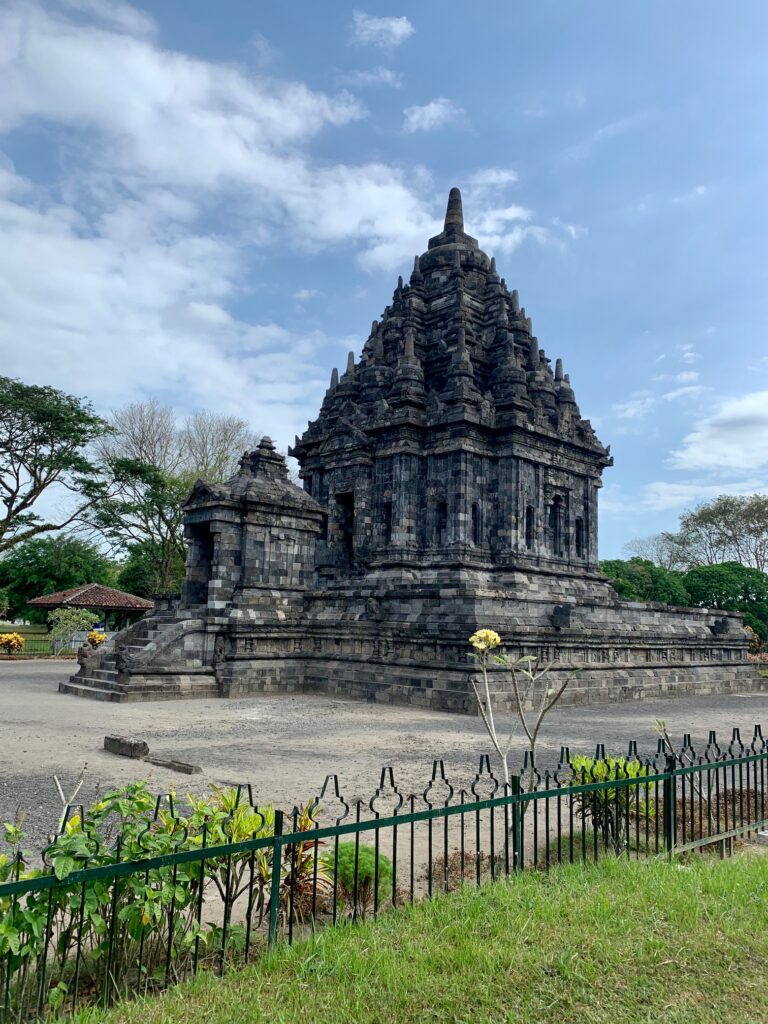

Bubrah Temple is another short walk north of Lumbung Temple. You can actually see it from the Lumbung Ruins fence. Bubrah temple is also fenced. Entrance to the ruins is at the East and West sides of the fence.
There is just one large temple that sits in the middle of the fenced area. There were only three other people that visited the temple when we were there. People are allowed to enter the temple. This is the place to get those Instagram shots are there were hardly anybody to compete with for a shot.
Sewu Temple
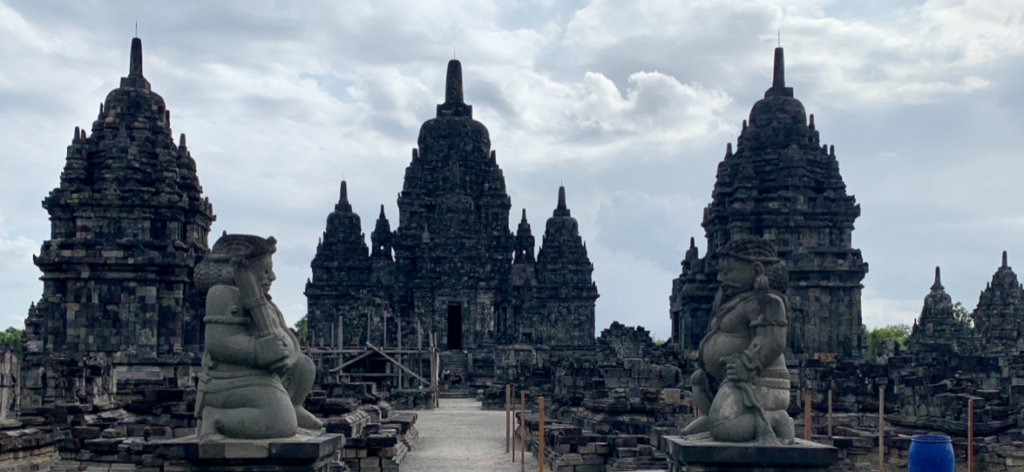

Sewu Temple is the northernmost temple in the complex. Just like Lumbung, it has a large temple surrounded by smaller temples. Unlike Lumbung, the Sewu temple is much larger and even larger than Brubah. It also has a lot more smaller temples that surround it and the complex is larger than Lumbung and Bubrah combined. Some of the smaller temples to the right of the main temple are still standing while the rest are just heaps of stones.
Perhaps the most well preserved part of this temple are the two Budda looking guard statues at the temple’s entrance. There were more people visiting this temple compared to Lumbung and Bubrah but nowhere near the number of people at Prambanan. We were still able to get our shots without having to wait to avoid being photobombed.
Borobudur Temple
Borobudur Temple is about 40 kilometers from the Yogyakarta’s city center. It is another impressive temple but different from the temples in the Prambanan temple complex. Borobudur is one giant temple that is 11 stories high. The entrance fee only gets you inside the park. There is an additional fee to climb the temple and you have to be with a guide.
Borobudur is worth a trip even though it takes longer to get to from Yogyakarta. Just like Prambanan, the place gets busy during the weekend and is closed on Mondays.
How to Get to Borobudur from Yogyakarta
We were warned by our hotel receptionist that the cell signal at Borobudur is spotty. So we contracted our Grab driver that took us back to our hotel from Prambanan. Our driver quoted us 400K IDR to drive us to Borobudur and back to our hotel. He said it would take about an hour and a half each way plus two hours allowance to see the temple.
My wife wanted to buy some batik clothing while we were in Yogyakarta. We earlier asked a local where he would batik clothing in Yogyakarta. Without hesitation, he said “Hamza Batik” store. Our driver quoted an additional 70K IDR to stop by the Hamza Batik store before he took us back to our hotel from Borobudur. We made it an even 500K IDR for essentially 7 hours of his service and his car. He was really happy and even thanked us profusely when we said that we would pay for the parking and his lunch at Borobudur.
Indeed, when we got to Borubudor, my wife’s cell phone did not have any signal. So we were glad that we had contracted a private driver for that day.
Seeing Borobudur Temple
Similar to Prambanan, there is a large sign for foreign visitors on where to buy the entry ticket. Like Prambanan, we entered a single story building and bought our ticket from the lady behind the counter. We were informed at Prambanan that the basic admission price at Borobudur is only to enter the temple grounds. There was an additional charge of about 80K IDR if we wanted to climb the temple. So we included this privilege in our admission. The additional charge comes with a guide service, a pair of sandals and a bag (more later). We were given wrist bracelets after paying with our credit card and were asked to go to the waiting area after the turnstiles.
We were handed a small laminated paper with a number prior to sitting in the waiting area. The number corresponds to the number on the flag that our guide was holding. Our guide took us to the sandal station and told us that we must wear sandals when going up the temple. This is to minimize the stone erosion from all the footsteps because the sandals soles are softer compared to shoes. We were also provided with a cloth bag so we could carry our shoes.
While waiting for our turn to go up, our guide talked about the philosophical meaning of the temple’s different levels. He said that the ground level is the level of desire, meaning those that have desires never get off that level. The temple’s highest level is the level of nirvana and enlightenment. Those that gave up their worldly desire are the ones that reach this level.
When it was our turn to go up the temple, our guide took us to the 4th level and gave a little talk about the temple’s history and how the government rebuilt the temple. He also said that the government had to relocate people that were living around the temple in order to make the area a park. Plus that was their way of reclaiming the stones that the locals took from the temple to build their houses.
Then our guide took us to the 6th level and he gave a talk about the story being told by the relief or carvings on some of the stone surfaces.
Finally he took us to the 8th level and said he would give us 20 minutes to roam around between the 8th and 10th levels. There were certainly some Instagram worthy shots at these levels provided you could catch a break from all the people trying to do the same thing. There were probably 50 to 60 people when we were there. It was not overly crowded but made it difficult to find a spot to get a clean camera shot.


Once our time was up, our guide took us down to ground level where our bracelet got scanned. Our tour was pretty much over and so was our time in the temple as we could not get back up after being scanned. I guess that is their way of controlling the number of people being up on the temple so it does not get overcrowded. We roamed around the temple grounds before heading back to our driver.
Impression
Yogyakarta’s temples are impressive. The surfaces of these temples have, as our Borobudur guide called it “relief” or carvings. And the relief tells a story. We could not imagine how much time was spent to painstakingly make those relief.
The rise in the steps at both temples are quite higher than normal stairs. There are steps that are between 12 to 15 inches in rise. Going up may be hard but going down may be treacherous especially if it rained.
Getting Out of the Temples
Just like any tourist attraction, the path that visitors take to exit the attraction normally passes through a souvenir shop. Typically, the souvenir shops are small and you can get out in a matter of seconds. That is not the case in Prambanan and Borobudur where we had to go through the market or “pasar”. We passed several stalls where the salespeople were calling to us to buy something.
It was not not too bad at Prambanan where we just had to walk a straight alleyway for about 200 or so meters. However, at Borobudur, it was a maze. There were multiple turns and long straightaways that we thought would not end. We were probably in the maze of stores for about 10 minutes before we saw daylight. And that was without stopping.
Tours
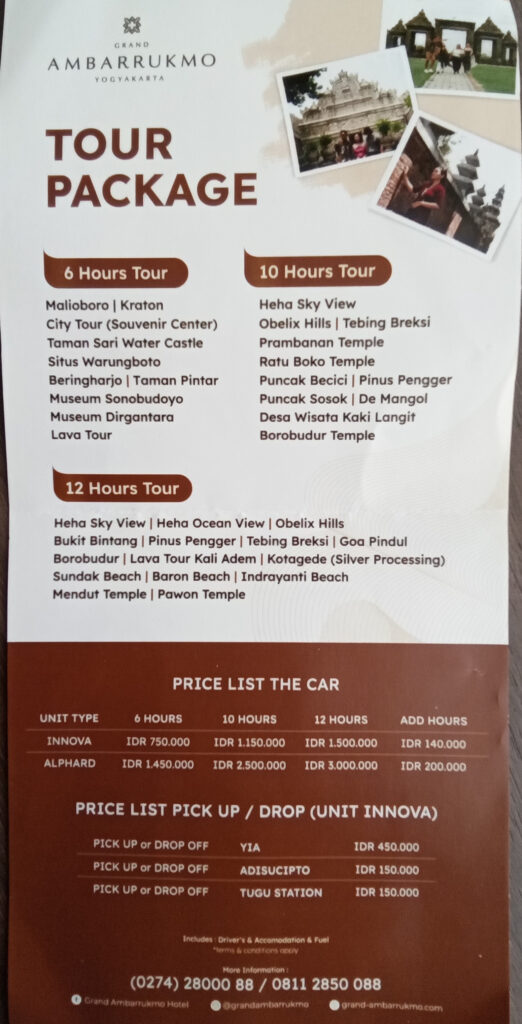

We wanted to include this tour flier that we got from our hotel. However, we forgot to confirm if the prices shown are per person or per vehicle (more likely). The hotel manager I talked to indicated that the rental vehicles come with a driver. You’ll just have to buy them food and drinks.
One thing that we want to mention is that it would be either a very long day to visit Prambanan and Borobudur on the same day or it would be a hurried visit to do both. It is about a 2 hour one way trip between Prambanan and Borubudor and that was with almost no traffic on the way to Borobudur.
It took us four hours to see the Roto Boko ruins and the ruins at the Prambanan complex and 2.5 hours in Borobudur. So that is 10.5 hours altogether just for those three locations. I could not imagine how they would squeeze in the other points of interest listed in the flier.
Summary
Prambanan and Borobudur temples are the main draw of Yogyakarta. These temples are busy during the weekend which unfortunately was the time when we visited both. We wanted to visit Borobudur on a Monday but the temples, including Prambanan, are closed during this day for regular maintenance. So plan your visits accordingly.
It is probably best to visit the two temples on different days. This way its not too tiring or not hurried. Hiring a rideshare is the best way to get to both temples. The people at our hotel said that the public transportation is not connected to allow us to get there using this mode of transportation.
Both temples are impressive. The artwork or “relief” is just something to be amazed with. The effort in creating these temples are just mind blowing.
Additional photos from Instagram.
